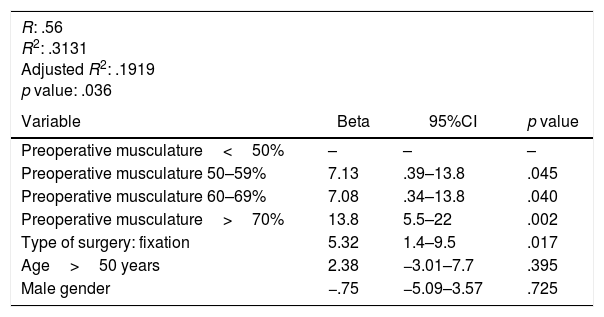Lumbar spine surgery causes a muscular injury during its approach that could worsen long-term postoperative functional results. This study aims to analyse the postoperative paraspinal atrophy associated with two types of intervention.
Material and methodsClinical records and lumbar magnetic resonance imaging were collected from a group of 41 patients, 20 underwent laminectomy with lumbar fixation due to lumbar spinal stenosis (fixation group) and another group of 21 underwent hemilaminectomy without fixation due to lumbar disc disease (non-fixation group). In which muscle atrophy was analysed quantitatively.
ResultsWe found a negative correlation between age and preoperative muscle, which was higher in those who underwent lumbar fixation (rho=−0.64 p=.002). We also found a positive correlation between preoperative muscle and postoperative atrophy (rho=0.32 p=.041). In the age, sex and fixation adjusted multivariate linear regression model (R2=0.31), laminectomy with fixation is attributed to 5.3% atrophy (IC95 1.4–9.5%, p=.017); preoperative musculature>70% is attributed to atrophy of 13.8% (95% CI 5.5–22%, p=.002). Age did not correlate with postoperative atrophy.
ConclusionsParaspinal muscle atrophy after lumbar spinal surgery is greater if an extensive approach is performed such as complete laminectomy with bilateral facetectomy and transpedicular fixation. A greater previous musculature regardless of age, sex and type of surgery also predicts greater postoperative atrophy.
La cirugía de columna lumbar produce una lesión muscular durante su abordaje que podría empeorar los resultados funcionales postoperatorios a largo plazo. Este estudio pretende analizar la atrofia paraespinal postoperatoria asociada a dos tipos de intervenciones.
Material y métodosSe recogieron historias clínicas y resonancias magnéticas lumbares pre- y postoperatorias de un grupo de 41 pacientes, 20 se sometieron a laminectomía con fijación lumbar por estenosis de canal (Grupo fijación) y otro grupo de 21 se sometieron a una hemilaminectomía sin fijación por enfermedad discal (Grupo no fijación). En los que se analizó la atrofia muscular de manera cuantitativa.
ResultadosSe halló una correlación negativa entre la edad y la musculatura preoperatoria, siendo mayor en el grupo laminectomía con fijación (rho = −0,64 p = 0,002). Observamos también una correlación positiva entre la musculatura preoperatoria y la atrofia postoperatoria (rho = 0,32 p = 0,041). En el modelo de regresión lineal multivariado ajustado por la edad, sexo y tipo de intervención, observamos que la predicción de la atrofia postoperatoria fue del 31% (R2 = 0,31); a la laminectomía con fijación se le atribuye una atrofia del 5,3% (IC95 1,4-9,5%, p = 0,017); a la musculatura preoperatoria > 70% se le atribuye una atrofia del 13,8% (IC95 5,5-22%, p = 0,002). La edad no se correlacionó con la atrofia postoperatoria.
ConclusionesLa atrofia muscular paraespinal que se produce después de la cirugía lumbar es mayor si se realiza un abordaje más amplio como la laminectomía completa con facetectomía bilateral y fijación transpedicular. Una mayor musculatura previa independientemente de la edad, el sexo y el tipo de cirugía también predice una mayor atrofia postoperatoria.
Article

If it is the first time you have accessed you can obtain your credentials by contacting Elsevier Spain in suscripciones@elsevier.com or by calling our Customer Service at902 88 87 40 if you are calling from Spain or at +34 932 418 800 (from 9 to 18h., GMT + 1) if you are calling outside of Spain.
If you already have your login data, please click here .
If you have forgotten your password you can you can recover it by clicking here and selecting the option ¿I have forgotten my password¿.
















